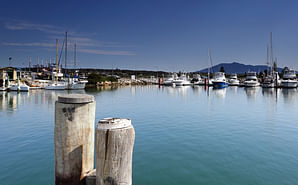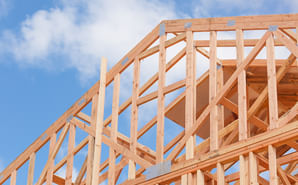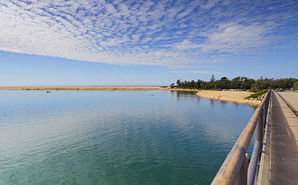Building steps check list
A checklist designed to help guide you through the planning process when building a dwelling or a shed, or doing alterations or additions.
This checklist is designed to help guide you through what you need for your building proposal.
To achieve a streamlined, fast development process, we recommend you engage the services of a suitably qualified building consultant/designer to put your application together for you.
Preparing to build a new home/alterations & additions or shed
-
Steps 1 and 2
Prior to lodgement confirm your property has a dwelling entitlement (if building a new dwelling).
This can be confirmed by emailing council@begavalley.nsw.gov.au and in some cases this may require a fee and a form for property information request to be completed.
-
Step 3
Prepare your design plans for your dwelling, alterations & additions or shed.
-
Step 4
Lodge your Development Application (DA) using the NSW Planning Portal.
-
Step 5
Receive approval via a Development Consent and Construction Certificate before building.
-
Step 6
Build to specifications.
-
Step 7
Request your final occupation certificate once all building work is complete.
To cut back on delays!
Make sure that: all forms are fully completed; and all documents are supplied at lodgement.
We’re here to help
If after reading the following information, you have any questions about the building process, please contact Development Support Services by phoning us on 02 6499 2222 or send an email to council@begavalley.nsw.gov.au
Steps in detail
To confirm if your property does have a building entitlement you can email council@begavalley.nsw.gov.au
Please include your property address, Lot/s & DP if possible and we will research this for you.
In some cases, this may require a form to be completed and a fee to be paid. Once you have this information, you’ll need to put together a development application (DA).
Items to be considered are: Bushfire Attack Level (BAL), Onsite sewage management system to manage effluent disposal (OSM), Biodiversity assessment requirements, Aboriginal Heritage and legal & practical access.
We would recommend you engage the services of a suitably qualified building consultant/designer/draftsperson to put together your house plans. Before you book in to meet with your consultant, there’s a few things that you need to consider:
- Your new home layout and look
- Development Control Plan Chapter 3
- If you are wanting to do alterations & additions to your current dwelling and need to obtain a copy of your house plans; you can obtain a copy through Customer Service by submitting a Request to view Property File/DA File Form. This will allow you to obtain copies of your house plans once you have sort approval from the holder of the copyright if the plans are subject to copyright. Some local designers and have given Council approval to copy plans and you will be advised at the time if you require copies whether you need to seek your own approval to obtain a copy of the plans. You can take these plans to your consultant to get updated plans drawn to meet legislative building standards.
- The Bushfire Attack Level (BAL) rating - see our useful information at the bottom of the page.
- Are you going to use a Licenced Builder or are you going to do Owner Builder? - see our useful information at the bottom of the page.
- Design to minimise clearing of native vegetation as far as possible as this will protect habitat for native species and require less biodiversity assessment.
For homes with young families or older occupants it is well worth considering a design that meets the Liveable Housing Design Guidelines
Lodging your application electronically
Your Development application (including modifications and reviews) must be submitted to Council online via the NSW Planning Portal.
For more information visit The DA Process
The Development Application should include:
- Statement of Environmental Effects
- Cost Summary Report
- Application to Install, Construct or Alter and operate a system of On-site Sewage Management (OSM).
- Application to connect to Sewer
- Water Management Act form if in Council’s water infrastructure area
- Application to Install Oil or Solid Fuel Heating Appliance (this is only required if installing a wood burning heater)
- Performance of Certification Work Contract of Agreement (if you are using Council for the certification/inspections
- A Section 138 (only if any works are proposed over the Council road reserve. i.e. new driveways)
- Your Site Plan
- Your House Plan which includes:
• Floor plan (with smoke alarms to be shown); • Any wood burning heaters that are included; Specifications; Elevations; Finished floor levels; North point shown on the plans; For rural and residential development, contour and level details that extend to the public road, not just to the boundary of the property; Engineering details if applying for a Construction Certificate; All plans to be dimensioned and to a suitable scale (eg: 1:100) - A BASIX Certificate (Your new homes energy efficiency report)
- An Aboriginal Heritage Information Management Systems (AHIMS) report. Application requirements:
Where a development will disturb the ground surface and/or may impact on Aboriginal cultural or spiritual values, the development application must demonstrate that a Due Diligence assessment has been undertaken by the applicant or a suitably qualified person - see 'Usefull Information' at the bottom of this page. - A Biodiversity Values Map & Threshold Tool (BMAT) report - If clearing native vegetation (including shrubs and groundcover) as part of the DA
- Owner/s consent, this is required if the applicant is not the registered land owner and needs to be provided in writing, e.g. letter of consent from owner. You can complete the Owners Consent Authorisation form and include this as an attachment on the NSW Planning Portal when submitting your application.
To find more on these, please see our 'Usefull Information' at the bottom of this page.
What are the fees involved?
The development application fees are based on the project value provided on your application to Council. Council must be satisfied that the project value is genuine and accurate. This figure must include all materials and labour.
Developer Contributions
In some cases Section 7.11 or 7.12 Contributions may be required to be paid before a Construction Certificate can be issued.
Section 7.11 Contributions are only charged on:
Subdivision of residential lots, Dual occupancy, Attached Dwellings, Semi-Detached Dwellings, Rural Workers Dwellings
Section 7.12 Contributions are based on the total project value for a proposed new dwelling on a lot where no Section 7.11 contributions were previously paid.
The contribution payable is worked out at:
For a proposed new dwelling on a lot where no Section 7.11 contributions were previously paid the contribution payable is worked out at:
- Up to $100,000.00 (Nil)
- $100,000.00-$200,000.00 (0.5% of cost)
- More than $200,000.00 (1% of cost)
Alterations & additions are charged at this same rate as above
Water & Sewer Headworks Contributions (Section 64)
If you wish to find out if any water & sewer headworks charges will be applicable or you require updated figures, please email council@begavalley.nsw.gov.au and include in the subject line Headworks Enquiry and list the Lot /s & DP and property address. You will receive a written response in return.
What are development contributions used for?
Development contributions are spent on community infrastructure identified in the schedule of works in Council’s contribution plan. This schedule reflects Council’s latest community infrastructure capital works priorities as well as the provision of local and district level roads, parks, sporting, recreation and cultural facilities and car parking facilities. Council can only levy contributions under Section 7.11 & 7.12 if the area for development in question falls under one of Council’s development contribution plans.
Find out more information about Council’s Contribution Plans
Once your Development Application has been approved and Contributions are paid (if applicable), you will receive a Construction Certificate (if Council is your appointed Certifier).
A Construction Certificate confirms that the construction plans and development specifications are consistent with the development consent and comply with the Building Code of Australia and any other Council requirements. A Construction Certificate can be issued by Council or a private certifier. Your Construction Certificate will contain all the information you need to know about the inspections required throughout the build process.
After you have received your Construction Certificate and Development Consent, you can start by submitting:
You can now start building.
Your builder or contractors will need to build to the plans and specifications. The inspections as outlined in the Development Consent will need to be followed throughout the process.
When the building is complete, arrange through Council, or your private certifier an occupation inspection.
Provided the proposed work is built to specifications, you will receive your Final Occupation Certificate or a Part Final Occupation Certificate.
Your waste bins will be ordered for you if this occupation certificate is for a dwelling (Only if located on a waste service route.).
Useful Information
Your level of bush fire risk affects your development requirements – the higher the risk, the more protection you need. We use the term ‘bush fire attack level’, or BAL, to quantify this risk. Your level of bush fire risk is affected by the area you live, the vegetation, the distance from the vegetation to your home, and the slope.
Council can undertake the BAL (Bushfire Attack Leve) assessment for you. This will be only up to BAL 40 (not flame zone).
You will need to complete the BAL assessment application form and pay the fee as listed on the form.
You can also find out your bushfire category by going to the NSW Planning Portal website www.planningportal.nsw.gov.au
Click on Find a Property
- Enter property address or Lot & DP
- On the left hand side of the screen under Hazard – click the down arrow and click in the box next to Bushfire Prone Land
- On the right hand side of the screen click the + symbol next to Bushfire Prone Land
- This will then show the bushfire category/categories relevant to your property.
- For category 1, 2 or 3 vegetation/grasslands or vegetation buffer you will need to complete Section Two Bushfire Assessment on pages 19-24 of Building in bush fire prone areas Single Dwelling Application kit to determine your BAL rating.
This document can be found at: https://www.rfs.nsw.gov.au/__data/assets/pdf_file/0017/4355/Guidelines-for-Single-Dwelling-Development-Applications.pdf
If you need to engage the services of a Bushfire Planning and Design Consultant (BPAD), a list of accredited assessors can be found at www.fpaa.com.au
Please contact the Development Hub on (02) 6499 2209 should you need any further assistance.
Biodiversity legislation can be complex.
Biodiversity Conservation Act
The Biodiversity Offset Scheme threshold (BOS) Threshold is a test used to determine when is necessary to engage an accredited assessor to apply the Biodiversity Assessment Method (the BAM) to assess the impacts of a proposal.
The thresholds for entry into the BOS are any of the following:
- Development is located on the Biodiversity Values Map
- Area clearing threshold is exceeded (refer to Table 1 below)
- Impacts to threatened species/communities (determined through a test of significance)
If clearing and other impacts exceeds the trigger thresholds, the BOS applies to the proposed development and a Biodiversity Development Assessment Report (BDAR) must be prepared and submitted with your application.
| Minimum lot size assocaited property | Threshold for clearing, above which the BAM and offsets scheme apply |
|---|---|
| Less than 1 ha | 0.25 ha or more |
| 1 ha to less than 40 ha | 0.5 ha or more |
| 40 ha to less than 1000 ha | 1 ha or more |
| 1000 ha or more | 2 ha or more |
Table - Biodiversity Offsets Scheme clearing area thresholds (Council can confirm which mimimum lot size applies)
Applicants are advised to check their proposal against the first two thresholds above by accessing the Biodiversity Values Map and Threshold (BMAT) tool at: https://www.lmbc.nsw.gov.au/Maps/index.html?viewer=BOSETMap
A BMAT user guide can be found at https://www.environment.nsw.gov.au/research-and-publications/publications-search/biodiversity-values-map-threshold-tool-user-guide
Council staff will assess the third threshold, impacts to threatened species, through a site visit. Should impacts to threatened species be likely further assessment by the applicant may be required.
Further information on the BOS can be found at https://www.environment.nsw.gov.au/topics/animals-and-plants/biodiversity/biodiversity-offsets-scheme/how-it-works#developers
Commonwealth Environmental Protection and Biodiversity Conservation Act (EPBC Act)
The EPBC Act is the Australian Governments key piece of environmental legislation, focussing on the protection of matters of national environmental significance including species and ecosystems.
Potential impacts to matters of environmental significance need to be assessed as part of a Development Application and council staff will assist applicants through this process. Further information on the EPBC Act and associated environmental assessment can be found at https://www.environment.gov.au/epbc/environment-assessment-and-approvals
Registered builders are insured tradesmen who manage the build including the contracting of licenced tradespeople. They are responsible for managing permits and organising inspections on your behalf.
As an owner builder, you take on many of the responsibilities of a registered builder and accept any associated financial risks. Responsibilities include:
- doing all or part of the work yourself, except work that must be carried out by licensed tradespeople
- contracting out all or part of the work to tradespeople, and checking they are registered and licensed if required
- choosing whether to engage a building consultant to independently advise you during the construction period. A building consultant can check the quality of your work and the work of those you engage
- arranging insurance
- occupational health and safety of workers
- obtaining permits and organising inspections.
Advantages may include:
- more control over the project, including design
- saving the cost of the builder’s margin
- more flexibility.
Risks include:
- spending more money and time than expected
- taking responsibility for the work and finance
- facing complex situations.
Your A3 site plan should include:
- First & secondary land application areas if having absorption trenches for an onsite sewage management system
- Site levels
- Storm water drainage
- The site plan. It will need to include all distances to boundaries and between proposed developments on your site.
- The Asset Protection Zone (APZ) area. The APZ dimensions need to demonstrate the boundaries of the property plus the distance and slope (in degrees) to the bushfire threat (hazard)
- The site plan will need to clearly label any trees that are there and any marked for removal. We will require photos of any trees that you may propose for removal as part of this build.
- If you are removing any native vegetation (including ground cover e.g. native grasses) you will need to complete the attached Biodiversity Values Map & Threshold Tool (BMAT) report- see link below to ensure the amount of clearing you are proposing to do is under the threshold. http://www.lmbc.nsw.gov.au/Maps/index.html?viewer=BOSETMap
- The site plan will need to show the calculations for clearing with all these areas considered: House footprint, earthworks, Asset Protection Zone, driveway, access road & site work.
- If you are not clearing any native vegetation, we will need a statement from you to confirm this. Photos should be included.
The Building Sustainability Index (BASIX) requirements apply to all residential dwelling types and are part of the development application process in NSW. In NSW, there are BASIX requirements for water and energy usage and thermal comfort performance that apply to:
- all new residential dwellings.
- alterations and additions to dwellings that cost $50,000 or more.
- swimming pools of 40,000 litres or more.
To obtain your BASIX Certificate, call the Department of Planning dedicated BASIX hotline 1300 004 914 or visit BASIX | Department of Planning Housing and Infrastructure (nsw.gov.au)
All BASIX commitments need to be clearly shown on plans & specifications. The certificate is only valid for three months.
If you are having issues obtaining this report on your property, contact ahims@environment.nsw.gov.au.
The Aboriginal Heritage Information Management System (AHIMS) is a database that contains detailed information on recorded sites of Aboriginal and Cultural Heritage. It is used to help identify, manage, conserve and protect local sites and heritage. In line with the current legislation, we require an Aboriginal Heritage Information Management Systems (AHIMS) report (this is a two page document) as part of your Development Application.
You will need to generate a basic AHIMS search using a 200 metre buffer.
Reports can be obtained from: https://www.environment.nsw.gov.au/awssapp/Login.aspx?ReturnUrl=%2fawssapp%2fMySearches.aspx
If you are having issues obtaining this report on your property, contact ahims@environment.nsw.gov.au
In accordance to legislative requirements, the Aboriginal Due Diligence Statement demonstrates that you have considered:
- any potential impacts on items of Aboriginal Heritage; plus
- the potential likelihood of Aboriginal artefacts being contained within the site to be disturbed; and
- that should any objects or places be found within the site, works will stop immediately and the relevant authorities will be contacted.
Report can be obtained from:
Due Diligence Assessment - Application requirements
Where a development will disturb the ground surface and/or may impact on Aboriginal cultural or spiritual values, the development application must demonstrate that a Due Diligence assessment has been undertaken by the applicant or a suitably qualified person. This includes (but is not limited to) submitting the following documentation in accordance with the Due Diligence Code of Practice for the Protection of Aboriginal Objects in NSW:
- A statement and results of a basic 200m AHIMS search. Where a site is identified within 200m of the development site the results of an extensive AHIMS search are required.
- A statement identifying whether the development site is partially or wholly within the area identified as having ahigh probability of Aboriginal cultural heritage values on the Aboriginal Cultural Heritage Landscape Map(see Figure 5.1b).
- A statement indicating whether there are landscape features that indicate the potential presence of Aboriginal objects. Landscape features include foreshore areas, creek lines, rocky areas, wetlands, ridge tops, ridgelines, headlands, sand dunes and caves. Figure 5.1a illustrates several landscape features where there is potential for Aboriginal sites to occur.
- A statement indicating if previous Aboriginal Cultural Heritage studies have been undertaken on the subject land Note: if any previous Aboriginal Cultural Heritage studies demonstrate that adequate Due Diligence was undertaken at that time, those reports can be taken into consideration. Council staff may be able to assist you in locating any previous reports.
- A statement indicating if the development site is a within a declared Aboriginal Place of Significance as listed in Schedule 5 of the Bega Valley Local Environmental Plan 2013.
For more information refer to the Development Control Plan (DCP)
Please contact Council if you require any further assistance with the lodgement process.
- Phone 02 6499 2222
- Email council@begavalley.nsw.gov.au






